
Vlad Yudkin
26 April, 2024
Local SEO vs National SEO vs Global SEO
Nowadays, over 90% of digital journeys begin on search engines. When individuals search for businesses, products, and services online, they usually start with a quick search. Luckily, SEO helps position your site prominently in search results.
However, if you're a local business aiming to increase visits to your physical location, how should you adapt your strategy? What makes local SEO different from national and standard, organic type, and which approach is more suitable for you? We will explore these questions and you will learn all you need to know about it!
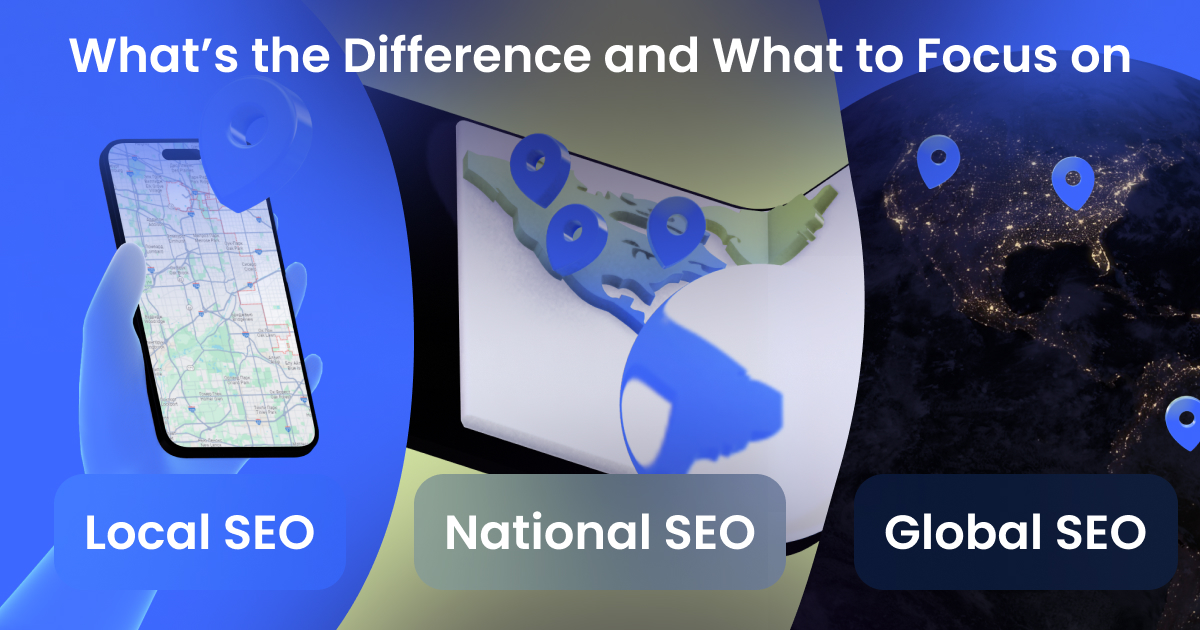
What is Global SEO?
Global SEO is aimed at optimizing a website to rank well in Google or other search engine results across multiple countries or regions. It involves targeting a broader audience by focusing on general search terms not limited to geographic specifics, thus maximizing online visibility on an international scale.
The structure of a traditional Google search results page (SERP) involves a combination of paid ads and organic listings, along with various SERP features that enhance user experience and provide direct answers to queries. Here's a more detailed breakdown:
Paid Ads
- Text Ads. Appear at the top and sometimes at the bottom of the search results. These are clearly marked with an 'Ad' label to distinguish them from organic results.
- Shopping Ads. For product searches, these visually-driven ads may appear, showcasing product images, prices, and the retailers offering them.
SERP Features
- Featured Snippets. Often called "position zero," these provide direct answers or summaries extracted from web pages, displayed prominently at the top.
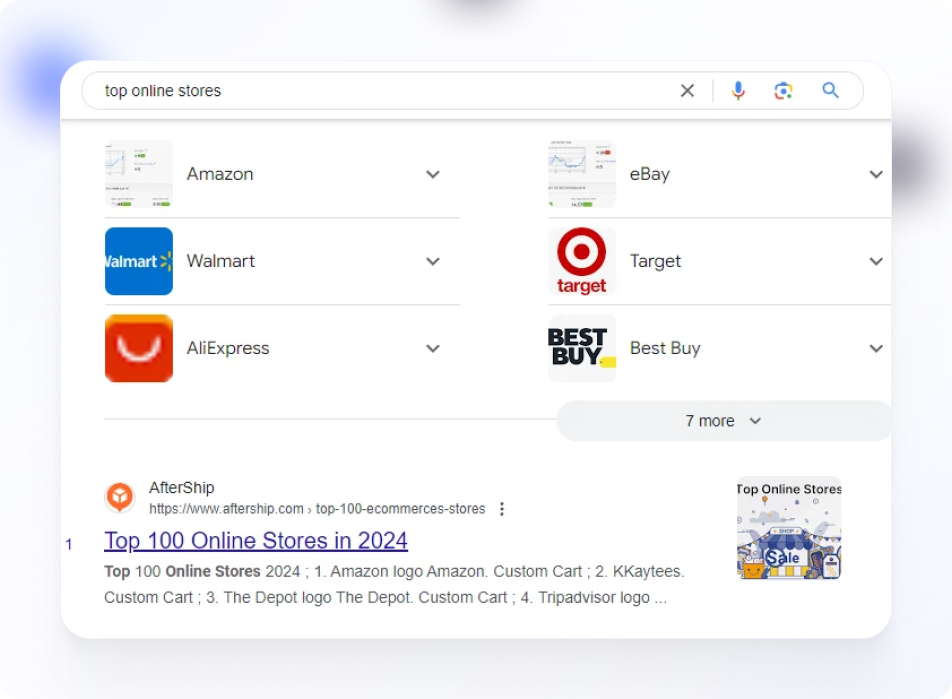
- For some websites, especially those with clear navigation and authority, Google might display additional links below the primary page link to help users navigate the site more effectively.
- Video content related to the search query may appear, especially if the query has a strong visual or instructional component.
- Reviews and Ratings. For products, services, or businesses, Google might display star ratings and reviews which can help users make informed decisions.
- AMP (Accelerated Mobile Pages). For mobile searches, AMP versions of web pages that load faster may be highlighted.
- 'People Also Ask' Boxes. A series of related questions and answers that expand to provide more in-depth information, helping users delve deeper into a topic.
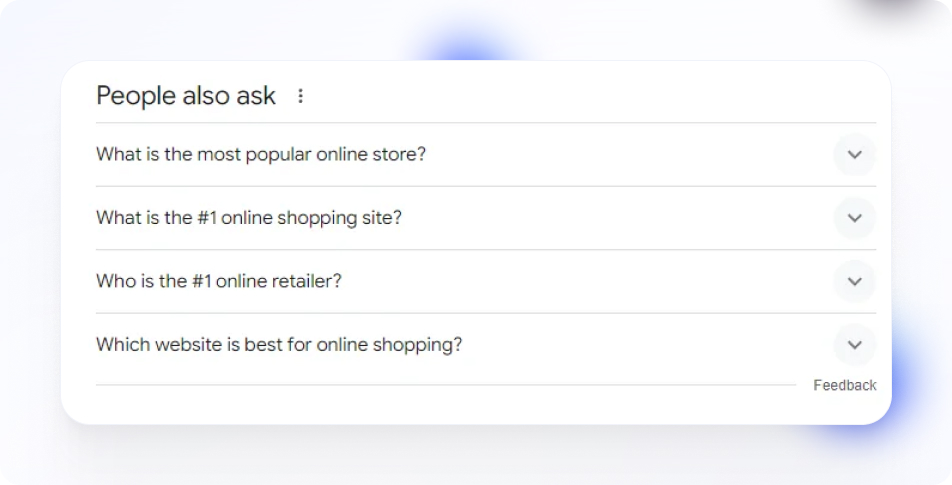
Organic Search Results. These are listings that appear due to their relevance to the search terms, rather than due to paid advertising. They are ranked by Google’s algorithms based on factors like relevance, authority, and SEO practices.
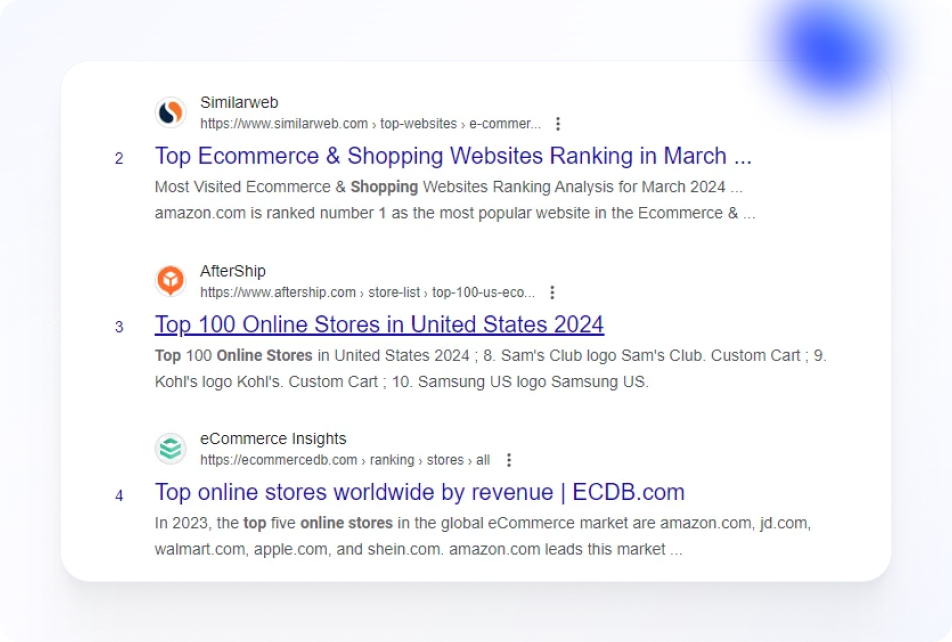
Knowledge Graph. For some queries, such as those involving notable people, places, or things, a panel may appear to the right of (or above on mobile) the organic results, providing key facts, images, and links to related content.
Focusing on regular SEO can provide several strategic benefits for businesses aiming to expand their reach across an entire country or several counties. Here are some key advantages:
- Broader Audience Reach. Regular SEO helps your website attract visitors from across the entire country or several places, not just a local area. This can significantly increase the total addressable market for your products or services.
- Enhanced Brand Visibility. By appearing in search results across various regions, your brand gains more exposure. This widespread visibility helps in building brand recognition and trust, which is crucial for companies looking to establish themselves as market leaders.
- Increased Website Traffic. Generally, regular SEO taps into larger search volumes because it targets broader search terms rather than geographically restricted ones. This leads to more organic traffic influx from diverse parts of the country.
- You can start by targeting broader keyword themes and as your business grows, refine your approach to target more niche segments within those themes. This scalability is invaluable for growing businesses.
- Competitive Edge. Successful global SEO approach can position your business prominently in search results, above even well-established competitors. This advantage is critical, especially in highly competitive industries.
- Diverse Customer Base. Regular exposure allows your business to attract a more diverse customer base. This diversification can enhance business stability and opportunities for market segmentation and targeted marketing strategies.
- Cost-Effectiveness. Compared to traditional nationwide advertising (like TV or print media), regular SEO can be more cost-effective, offering a higher return on investment (ROI). Organic search traffic typically provides sustained long-term benefits at a lower ongoing cost.
- Greater Online Authority. It can also elevate your website’s authority through increased backlinks, social media mentions, and high-quality content distribution. This not only boosts SEO performance but also enhances the overall credibility of your business.
- Long-term Results. SEO is a long-term marketing strategy. Once established, it can continuously drive traffic and leads over time, unlike paid advertising which stops the moment funding is paused.
To gain the benefits listed above, businesses must implement various SEO strategies effectively. These strategies revolve around several core pillars of SEO, each contributing uniquely to enhancing a website's visibility, user experience, and interaction with search engines across different markets. These best practices include:
- Keyword Research. Identifying the right keywords that target audiences are searching for in different regions, considering local language variations and search behaviors.
- Content Optimization. Creating high-quality, engaging, and localized content that meets the needs and interests of a global audience, ensuring it is culturally and contextually relevant.
- On-Page Optimization. Ensuring that all elements on the web pages (like titles, meta descriptions, header tags, and internal links) are optimized for the main keywords and structured properly for both users and search engines.
- Off-Page Optimization. Building a robust profile of backlinks from credible sources within targeted regions to enhance the site’s authority and relevance in the eyes of search engines.
- Backlinking Strategy. Developing a strategic approach to earning backlinks from reputable and relevant websites, which helps in improving the site's credibility and search engine ranking.
- Technical SEO. Optimising technical aspects to help search engines crawl and index the site more effectively, which includes improving site speed, ensuring mobile-friendliness, and implementing secure protocols like HTTPS.
There are numerous strategies available for optimizing a website for search engines, we've highlighted just the core ones that form the foundation of any successful SEO campaign.
Some businesses, particularly those with physical locations or those that provide services in specific geographic areas, benefit more from a local approach which targets nearby customers. Which strategy should be chosen in this case? Read on and explore the differences to understand which search engine optimization strategy best suits specific business needs.
What is Local SEO?
Local SEO is a strategy that helps your business become more visible in search results on Google for a certain location. For instance, imagine someone looking for a place to dine and search, "top Italian restaurants in Boston." If you operate an Italian restaurant in Boston, you'd want your establishment to appear prominently in the local search results for that query. Employing local SEO strategies can help achieve that.
Beyond SERP features, ads, and organic listings, local search results also include specific unique elements.
- Local SEO 3-Pack. Also known as the "Snack Pack" or "Local Pack", this feature displays the top three local business listings most relevant to the search query. It provides critical information such as business names, ratings, and locations, often shown alongside a map.
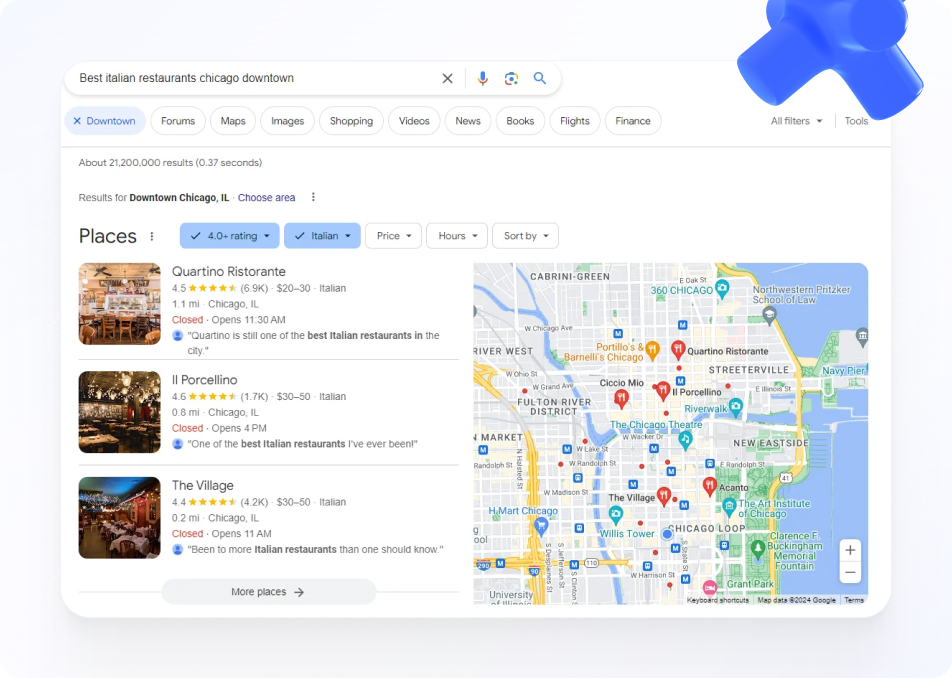
- Google Local Services Ads. These are paid advertisements that appear at the very top of the local search results. They are typically for service-oriented businesses like plumbers or electricians and include features like Google Guaranteed badges, which help build trust. Those are available only for certain cities and industries.
- Google Maps Results. Integrated directly into the SERP, Google Maps highlights local businesses relevant to the search query on a map interface, allowing users to see their exact locations and offering directions.
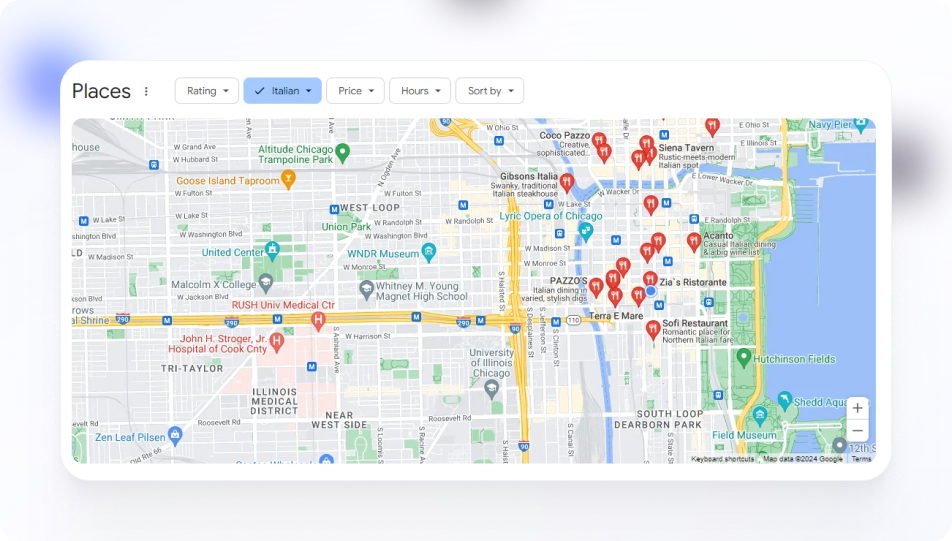
- Reviews and Ratings. Prominently displayed within local listings, these elements help users quickly assess the quality and reliability of local businesses.
- Rich Snippets. These include additional details like business hours, pricing, availability, or popular menu items directly in the search results.
- Knowledge Panel. For some companies, Google generates a detailed knowledge panel that can appear on the right side of the search results on desktop or at the top on mobile. It compiles detailed information about the business, including photos, descriptions, reviews, and even social media links.
- Localized Content. This might feature images, local offers, or events pertinent to the area, which resonate well with local search queries.
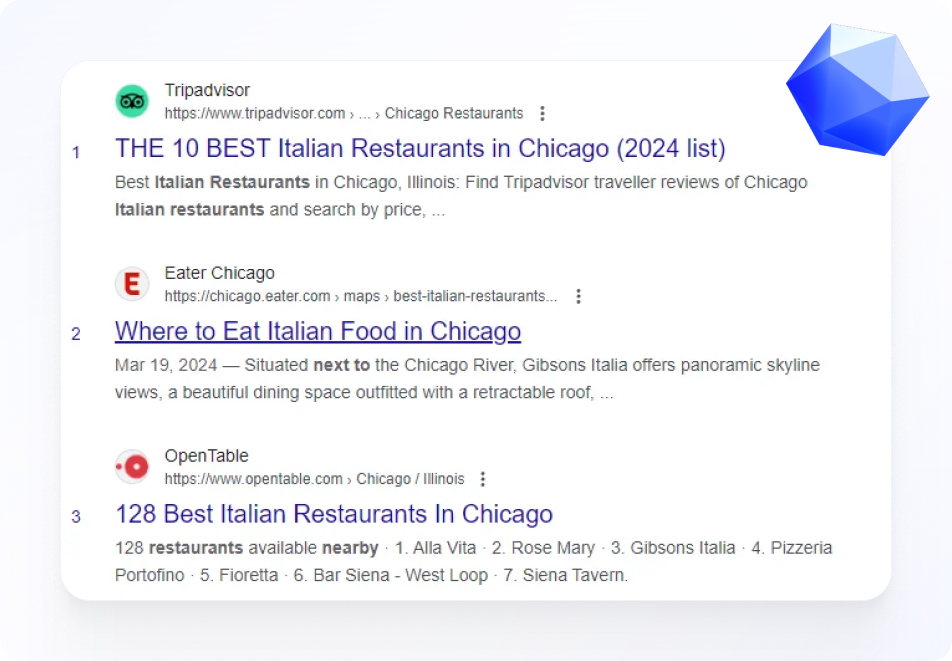
These unique features enhance visibility and provide vital information directly in the search results, making it easier for users to choose a service or visit a location.
The main benefits of optimizing for local searches include:
- Increased Local Visibility. Businesses appear prominently in search results when potential customers in their vicinity are actively looking for their products or services. This heightened visibility directly impacts foot traffic and inquiries.
- Targeted Reach. Optimization efforts are specifically geared towards an audience within a certain geographic area. This ensures that marketing efforts are concentrated on attracting the most relevant customers who are more likely to convert.
- Boost in Traffic. With improved visibility and higher rankings, there is a significant increase in traffic to the business website or physical store. This includes not just any traffic, but high-quality, locally-targeted traffic.
- Competitive Advantage. Standing out in local results can place a business ahead of competitors. Better visibility means a higher probability of attracting first-time customers and securing their loyalty.
- Cost-Effectiveness. Compared to broader, more general marketing campaigns, focusing on local audiences can be more cost-effective and yield a higher return on investment.
- Community Engagement. Being prominent in local searches fosters a stronger connection with the local community. This can lead to word-of-mouth referrals and repeat business, strengthening the business's reputation locally.
- High Conversion Rates. Local search listings often provide potential customers with all the information they need to make a purchase decision immediately. Over 80% of searches with local intent lead to conversions.
Common local SEO keywords typically include geographical identifiers coupled with industry-specific terms to target users searching for specific products or services within a certain area. Here are several examples of how these keywords tend to be structured:
[Service/Product] in [City/Neighborhood]
- "plumbers in Chicago"
- "coffee shops in downtown Boston"
[Service/Product] near me
- "restaurants near me"
- "car repair near me"
Best [Service/Product] in [City/Neighborhood]
- "best dentist in San Francisco"
- "best Italian restaurant in Midtown"
[City/Neighborhood] [Service/Product]
- "Seattle yoga studios"
- "Manhattan women’s boutiques"
[Service/Product] [City/Neighborhood] reviews
- "Miami hotel reviews"
- "Austin auto mechanic reviews"
Even if you manage a niche business that may seem challenging to expand, local SEO can significantly enhance your growth prospects. To truly harness the benefits and maximize your visibility, adopting a localized approach is essential. Here are some best practices:
- Optimize Your Google My Business Profile. Keep your profile updated with accurate information, compelling photos, and regular posts about promotions or events.
- Encourage and Manage Online Reviews. Actively seek reviews from your customers and respond to them promptly to show that you value their feedback and engagement. Management of reviews is very important.
- Ensure Local Citation Consistency. Verify that your business’s name, address, and phone number (NAP) are consistent across all directories and listings to improve your rankings.
- Create Locally Relevant Content. Tailor your content to include news, events, or activities, and use local keywords that reflect your community and address specific interests.
- Optimize Website for Local Keywords. Include area-specific keywords in your tags, headings, and content, ensuring they resonate with your audience.
- Build Local Backlinks. Establish connections with newspapers, blogs, and other businesses to secure valuable local backlinks, enhancing your site’s authority and relevance in your area.
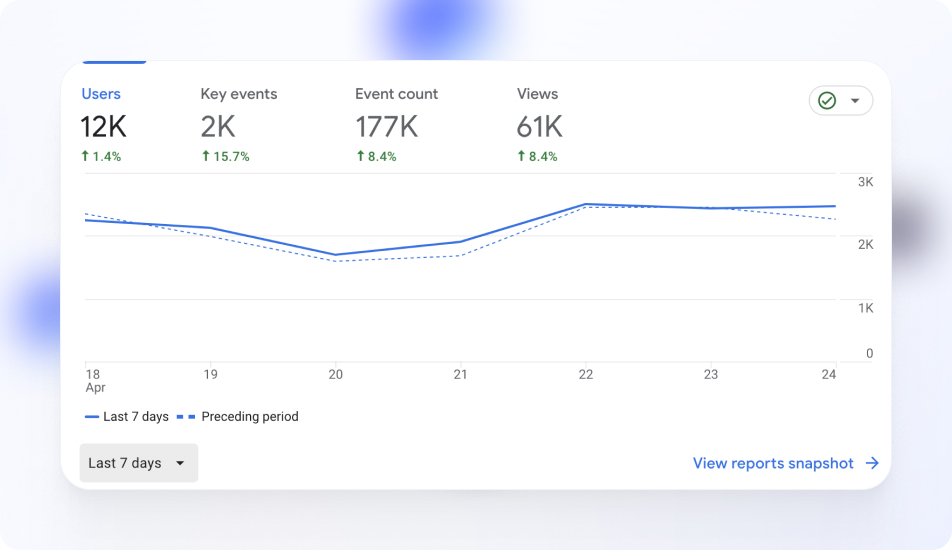
What is National SEO?
National SEO is a strategy focused on broadening a website's visibility on a national scale, targeting generic keywords that are not specific to any geographic location. This approach is ideal for businesses that offer products or services across an entire country or in multiple regions, rather than being confined to a specific locality.
National SEO offers several benefits compared to strategies focused on optimizing for specific geographic locations:
- Broader Audience Reach. National SEO targets a country-wide audience, which significantly expands the potential customer base compared to strategies that concentrate on attracting customers from a specific city or region.
- Increased Brand Visibility. By targeting a countrywide audience, companies can enhance their brand recognition and establish a presence across multiple regions, rather than being known in just one locality.
- Higher Traffic Potential: National SEO taps into larger search volumes because it uses more general keywords that are searched by people across the entire country, potentially leading to a higher overall number of site visitors.
- This strategy is well-suited for businesses looking to scale operations or expand their market reach beyond local boundaries, providing a foundation for growth without geographical constraints.
- Diverse Market Opportunities. Countrywide SEO allows businesses to explore and adapt to various market dynamics and consumer behaviors across different regions, which can inform broader marketing strategies and product offerings.
National SEO vs Local SEO: What is The Difference?
Although national and local SEO both operate within one country, local SEO specifically targets smaller, more defined areas such as cities or neighborhoods, focusing on the unique needs and characteristics of nearby consumers.
How is national SEO different:
- Geographic Focus. Does not prioritize geographic-specific terms or local business listings, unlike local SEO, which targets specific cities or regions to attract a closer audience.
- Keyword Strategy. Uses more general and highly competitive keywords, while local SEO incorporates location-based keywords to capture traffic from specific areas.
- Audience Reach. Aims to reach a broader audience across the country, whereas Local SEO focuses on engaging customers near the business location.
- The intent behind National SEO is to build brand recognition and capture traffic from across the nation, while local SEO aims to drive foot traffic and local engagements.
Local SEO vs SEO
Local and traditional SEO are both strategies used to improve your rankings in Google. However, they differ significantly in their focus and methods.
Keyword Strategy
Regular: Targets more general, broad keywords that are not necessarily linked to a geographic location. The goal is often to attract traffic from users globally or from larger, non-specific areas.
Local: Focuses on location-specific keywords that usually include the name of the city or region. Local SEO aims to capture the regional search market where the physical presence of the business is crucial.
Target Locations
Regular: Aiming for a wider audience without geographical constraints.
Local: Specifically targets local consumers by optimizing for cities, neighborhoods, or regions where the business operates. The goal is to appear in searches that are relevant to the business's immediate geographical area.
Users’ Intentions
Regular: The intent can vary widely, from informational (learning about something) to transactional (buying a product online). It casts a wider net in terms of the content and user engagement strategy.
Local: Often focuses on attracting searchers with immediate needs or those in the decision-making stage, looking for products or services locally. The intent is highly transactional or direct-query based, when someone needs to find the nearest coffee shop, plumber, or real estate agent.
Backlink Building
Regular: Prioritizes building a diverse range of backlinks from high-authority websites and industry-related platforms globally. The quality and relevance of the link are crucial, aiming to boost the overall authority and trustworthiness of the website.
Local: Focuses on obtaining backlinks from locally relevant websites, such as local business associations, community blogs, or local news websites. These help to establish local relevance and authenticity in the eyes of both consumers and search engines.
Competition
Regular: Competes in a broader market, which often means going up against large, well-established players on an international scale. This can make ranking highly for competitive keywords more challenging.
Local: Competition is limited to businesses within the same locality or region. While this might reduce the number of competitors, the intensity of competition in densely populated areas or for popular services can be quite high.
Are you having a hard time deciding which SEO strategy will benefit you more?
We can helpLocal SEO vs Organic SEO vs National SEO: How to Pick the Correct Strategy?
Choosing between national, local SEO vs regular SEO depends on several factors related to your business model, target audience, geographical service area, and overall marketing objectives. Let’s explore how to determine which SEO strategy suits your business needs.
Factors to Consider for Local SEO:
- Business Location. If your business operates physical locations where customer presence is required, like restaurants or retail stores.
- Local Customer Base. Your primary customer base is located in a specific geographical area close to your business.
- Service Area. You offer services that are geographically confined, like plumbing or landscaping. Your business is area based (SAB – service area business).
- Local Competition. You need to compete against other local businesses rather than on an international scale.
- Community Engagement. Your business benefits from community involvement and events.
Examples of Businesses Suited for Local SEO:
- Restaurants and cafes;
- Retail stores;
- Home services (plumbers, electricians);
- Law firms;
- Medical practices (dentists, chiropractors);
- Real estate agencies;
- Gyms and fitness centers.
Factors to Consider When Choosing Organic SEO:
- Broader Audience. You aim to reach customers at an international level.
- Online Services. Your business offers services or products that can be provided remotely or shipped globally.
- Digital Products. You sell digital products (e.g., software, eBooks) or offer online courses.
- Content Reach. You want your informational content to reach as broad an audience as possible.
- Your business model supports and aims for growth beyond the local market.
Examples of Businesses Suited for Organic SEO:
- E-commerce stores;
- Online consulting or coaching services;
- Software companies;
- Content publishers (news sites, blogs);
- Travel services and travel booking sites;
- Educational platforms offering online courses;
- Companies selling unique or niche products not tied to a specific location.
Factors to Decide on National SEO:
- Business Scope. Operating, servicing, or targeting customers across multiple states or the entire nation.
- Online Competition. Comparatively lower or beatable in a national market versus local competitors.
- Product/Service Demand. Uniformity of product or service demand across various regions.
- Brand Expansion Goals. Plans for national recognition and establishing a widespread brand presence.
- Digital Presence. Evaluation of online traffic sources, aiming for a broad audience rather than local foot traffic.
- Budget and Resources. Adequate budget and resources to compete on a national scale.
Examples of Businesses Suitable for National SEO:
- E-commerce retailers;
- Technology solutions providers;
- Online education platforms;
- National health and wellness brands;
- Legal services with nationwide coverage;
- Automotive manufacturers;
- Job and employment portals.
Ultimately, while many businesses will primarily lean towards one strategy, combining elements of both local and organic SEO can sometimes offer the best of both worlds, especially for those that operate both locally and online.
Countrywide SEO vs Local SEO vs Global SEO: Summary
Choosing the right strategy — whether local or organic — requires careful consideration of various factors, including your business model, target audience, and geographical scope.
Local SEO is ideal for businesses that operate in physical locations and cater predominantly to a local clientele. It focuses on optimizing search visibility within a specific geographic area, making it critical for service-based or community-focused businesses. A countrywide approach will let you grow even more.
On the other hand, organic SEO targets a broader, international audience, and is suitable for businesses that offer digital products, e-commerce, or content that appeals globally. While both strategies offer significant benefits, it's important to realistically assess your company's resources and market potential.
For small businesses, attempting global SEO might be challenging without sufficient resources. Each has its unique advantages and can substantially benefit a business in its context.
We hope that our article has helped you understand the differences between local and organic SEO, and now you can make the right decision more easily! If you require digital marketing services, our agency will gladly assist you.
Faq
Organic SEO vs local SEO – can I use both strategies instead?
It absolutely works! Using both local and regular strategies can be highly beneficial, especially for businesses that operate on multiple scales or have diverse target audiences. Combining these strategies allows you to tailor your SEO efforts to specific markets while also broadening your reach. You can just take the best from both approaches.
For instance, if you run a restaurant chain with multiple locations across the country, local SEO can help drive foot traffic to each specific location by targeting geo-specific audiences, while regular SEO can enhance your overall brand presence and attract larger partnerships or franchise opportunities. This integrated approach ensures you capture both localized and widespread visibility, maximizing your online potential. Ultimately, the decision to integrate both should depend on your specific business goals, resources, and the nature of your services or products.
How do local and global SEO impact each other?
While targeting different audience scopes, these strategies can significantly influence one another in various ways. On one hand, strong local SEO can bolster your overall domain authority and credibility, which positively impacts your global SEO efforts.
Conversely, a robust global SEO strategy that improves your general visibility can indirectly benefit your local SEO rankings. This happens as increased brand recognition drives more searches specifically for your business.
How can I say that my local SEO strategy is successful?
A success of your local SEO strategy can be identified through improved rankings in desired SERPs, increased local website traffic, and heightened user engagement, including more online interactions and positive reviews. Additionally, seeing a boost in conversion rates from visitors turning into customers is a strong indicator of effective tactics. Monitoring these changes allows you to gauge the impact of your SEO efforts accurately.





